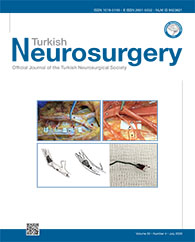2Ankara Numune Education and Research Hospital, Department of Neurosurgery, Ankara, Turkey
3Antalya Education and Research Hospital, Department of Neurosurgery, Antalya, Turkey
4Hacettepe University Faculty of Pharmacy, Depatment of Pharmaceutical Technology, Ankara, Turkey
5Neurosurgeon in Private Practice, Ankara, Turkey DOI : 10.5137/1019-5149.JTN.24303-18.2 AIM: To evaluate the possible neuroprotective effects of systemic administration of cyclosporine (Cyclosporin A) after traumatic brain injury in rats.
MATERIAL and METHODS: The modified Feeney method was used as the trauma model in male Sprague Dawley rats. After the trauma, 20 mg/kg of cyclosporine was administered to the one group of the rats (n=12) intraperitoneally. Twenty-four hours after injury, the subjects were sacrificed, and brain samples were removed. The level of brain edema was evaluated through the wet-dry weight method, the lipid peroxidation ratio, and histological examination by transmission electron microscopy.
RESULTS: The level of brain edema and lipid peroxidation ratio significantly decreased in the rats that received cyclosporine. Ultrastructural neurodestruction was graded, and a comparison of the scores between the experimental groups revealed significant neuroprotective effects of cyclosporine.
CONCLUSION: The results demonstrated that systemic administration of cyclosporine produces a statistically significant decrease in both the level of brain edema and lipid peroxidation ratio when compared with ?no treatment?. Cyclosporine, which is regularly used as an immunosuppressant agent, is also known to prevent opening of the mitochondrial permeability transition pore by unbinding mitochondrial matrix cyclophilin. Regulation of transition pore for mitochondrial permeability by cyclosporine implies that mitochondrial dysfunction following traumatic brain injury is an important event in the progressive loss of neuronal tissue.
Keywords : Cyclosporine, Neuroprotection, Mitochondrial permeability transition pore, Traumatic brain injury, Rats




